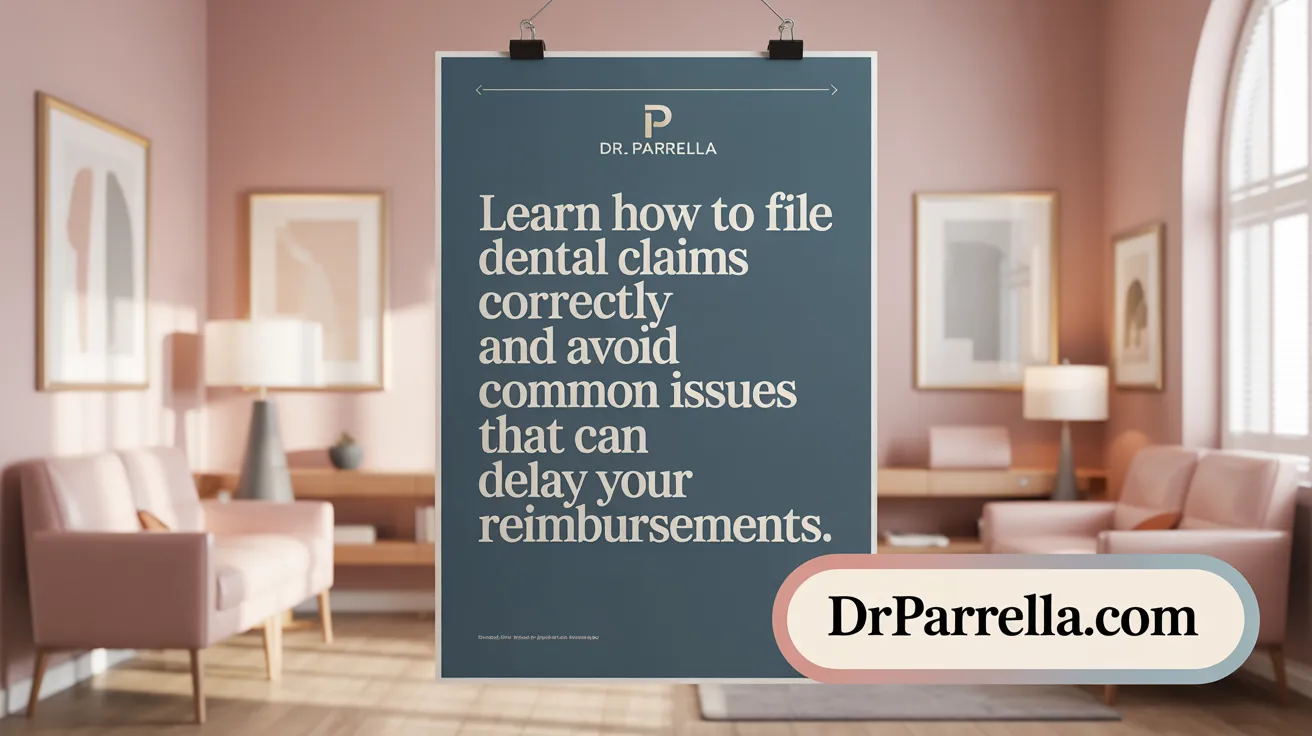Demystifying Dental Insurance for Patients
Dental insurance can often seem complex and confusing to patients, but understanding its essentials can lead to better oral health outcomes and financial savings. This guide aims to explain the key aspects of dental insurance, types of plans available, coverage details, costs involved, and practical tips to maximize benefits effectively.
Basics of Dental Insurance: How It Works
What is dental insurance and how does it generally work?
Dental insurance is a financial product designed to help patients offset the costs of dental care by covering a portion of dental services, primarily focusing on preventive dental care coverage. Patients pay a fixed monthly premium to keep coverage active. Most plans include a deductible — the amount a patient pays out-of-pocket before the insurance starts covering costs.
Key insurance terms
- Premium: A fixed monthly payment made to keep the insurance plan active. See more about dental insurance premiums.
- Deductible: An out-of-pocket cost the patient must pay before the insurer contributes. Learn about what is a deductible in dental insurance.
- Copay: A set dollar amount paid by the patient for a service. Explanation regarding copayments.
- Coinsurance: A percentage of the treatment cost shared between patient and insurer after deductible is met. See details on coinsurance and copayments explained.
- Annual Maximum: The yearly cap on the total benefits the insurance will pay. More information on annual maximum in dental plans.
Coverage model and cost-sharing structure
Dental plans typically use a tiered coverage approach where preventive services such as cleanings and check-ups are covered close to 100%. Basic procedures (e.g., fillings, root canals) usually have about 80% coverage, and major services (e.g., crowns, dentures) often have approximately 50% coverage. This is commonly known as the 100-80-50 dental coverage rule. Patients pay their share through copays or coinsurance after meeting any deductible.
Common exclusions
Dental insurance generally excludes cosmetic treatments like teeth whitening, veneers, and bonding, as these are not medically necessary procedures. It's important for patients to verify coverage details for specific treatments, especially for services like dental implants and braces, which may have limited or no coverage depending on the plan.
Types of Dental Insurance Plans Explained

What different types of dental insurance plans are available and how do they differ?
Dental insurance comes in several forms, each varying in provider access, costs, and coverage features:
-
PPO (Preferred Provider Organization): This is the most common dental insurance type, offering a broad network of contracted dentists with negotiated fees. Patients benefit from lower costs when using in-network providers but can still visit out-of-network dentists at higher out-of-pocket rates (PPO dental plans overview, PPO dental plans, Dental PPO plans, PPO dental insurance plans).
-
DHMO (Dental Health Maintenance Organization): These plans feature smaller dentist networks and often require patients to select a primary care dentist and get referrals for specialist care. They have lower premiums, typically no deductibles or annual maximums, but restrict coverage to in-network treatment (DHMO dental plans features, DHMO dental plans, DHMO dental insurance plans.
-
Indemnity Plans: Traditional insurance plans allowing patients to visit any dentist. They tend to have higher premiums, deductibles, and coinsurance and reimburse based on usual, customary, and reasonable (UCR) fees (Indemnity dental plans pros and cons, Indemnity dental plans).
-
Dental Discount Plans: These are membership programs offering reduced fees from contracted dentists. They are not insurance, requiring no claims or annual maximums but only provide discounts rather than payments (Dental discount programs vs insurance, Dental Discount Plans).
-
Other Plans: EPO (Exclusive Provider Organization) plans require in-network care only, similar to DHMOs but with PPO-style networks. Point of Service plans allow out-of-network visits with reduced benefits and usually need referrals (EPO dental plans, Point of Service dental plans.
Network restrictions and choices
Network size and requirements vary significantly:
- PPO plans allow freedom to choose any dentist but save more in-network (In-network vs out-of-network providers, In-network vs out-of-network dentists).
- DHMOs limit care to specific dentist networks,
- Indemnity plans provide complete freedom but are more costly.
- Discount plans require use of designated providers for savings.
Cost and coverage differences across plan types
| Plan Type | Premiums | Deductibles | Provider Choice | Coverage Scope |
|---|---|---|---|---|
| PPO | Moderate-High | Yes | Flexible | Preventive, basic, major with limits (Dental insurance coverage) |
| DHMO | Low | Usually none | Restricted | Preventive focus, fewer major services (DHMO dental plans |
| Indemnity | High | Yes | Wide | Broad but with higher cost-sharing (Indemnity dental plans |
| Discount | Low (Membership) | None | Restricted | Discounts only, no insurance benefit (Dental discount plans |
Benefits and limitations of each type
- PPO plans balance cost, flexibility, and broad coverage but often have deductibles and annual maximums (Dental insurance basics, Dental insurance premiums).
- DHMO plans offer low-cost care with limited provider choice and often no annual benefit caps.
- Indemnity plans give unrestricted provider choice but at higher personal costs (Indemnity dental plans pros and cons).
- Discount plans reduce upfront prices but do not reimburse any fees and lack protections such as annual maximums.
Selecting a suitable plan depends on your preferences for cost, provider access, and the range of covered services (Choosing the right dental insurance plan).
Understanding Coverage: What Dental Insurance Typically Pays For
What kinds of dental procedures are covered and at what levels?
Dental insurance generally covers a range of dental services categorized as preventive dental services coverage, basic dental procedures coverage, and major dental services coverage. The coverage often follows the 100-80-50 dental coverage rule:
-
Preventive Services: These include routine checkups, cleanings, X-rays, fluoride treatments, and sealants. They are typically covered at nearly 100%, with no deductibles or waiting periods, encouraging regular dental visits to avoid more serious issues (see preventive dental care coverage, preventive dental care, and coverage for preventive dental services).
-
Basic Procedures: This category includes fillings, simple tooth extractions, root canals, and treatment for gum disease. Coverage rates for these services usually range from 70% to 80%, depending on the plan. Patients may need to pay deductibles and coinsurance costs (basic dental procedures coverage, coinsurance and copayments explained.
-
Major Services: More complex treatments such as crowns, bridges, dentures, oral surgeries, and complex extractions tend to have lower coverage, commonly about 50%. These services often require waiting periods — sometimes up to twelve months — before benefits apply (major dental services coverage, waiting periods for dental procedures).
Orthodontic coverage, including braces, is less frequently included in standard plans and is often limited to children with lifetime maximums (orthodontic coverage in dental plans, dental insurance exclusions). Similarly, dental implants coverage is not always included or may have coverage restrictions.
Waiting periods are typical for basic and major procedures, although preventive care is often covered immediately upon enrollment (dental insurance waiting periods, preventive dental care coverage).
Understanding these coverage nuances helps patients plan treatments and manage out-of-pocket expenses effectively (maximizing dental insurance benefits.
Costs and Financial Responsibilities in Dental Insurance

What are the common costs a patient should expect with dental insurance?
When managing dental insurance, patients should be aware of several types of costs. First, premiums are fixed monthly payments that keep the insurance active, similar to a subscription fee. Before insurance starts paying for services, patients often must meet a deductible—a set out-of-pocket amount—although preventive care services are typically exempt.
Next, copayments are fixed fees paid during each dental visit or for specific procedures, while coinsurance represents a shared percentage of treatment costs between the patient and insurer after the deductible is met. For example, a common structure covers 100% of preventive care, 80% of basic procedures, and 50% of major dental work.
Most plans have an annual maximum benefit, often ranging between $1,000 and $2,000, which limits the total amount the insurer will pay for dental care within a plan year.
Choosing in-network providers usually reduces out-of-pocket costs, as these dentists have agreed to negotiated fees, whereas using out-of-network dentists can result in higher expenses due to balance billing.
Additionally, patients can take advantage of tax-advantaged accounts like Flexible Spending Accounts (FSAs) and Health Savings Accounts (HSAs). These accounts allow for pre-tax contributions to cover dental expenses, making budgeting for dental care more efficient.
Understanding and planning for these financial responsibilities helps patients maximize their dental insurance benefits and manage their oral healthcare expenses effectively.
Maximizing Your Dental Insurance Benefits

How can patients get the most out of their dental insurance plans?
To get the fullest benefit from dental insurance, start by focusing on preventive dental care coverage. Most plans cover routine checkups, cleanings, and X-rays at 100%, encouraging regular visits that can prevent severe dental problems and expensive treatments later.
Staying in-network is a smart strategy. Insurance companies negotiate reduced fees with certain dentists, so choosing these providers means lower out-of-pocket costs and smoother claim processes.
Plan your treatments carefully within your benefit year. Since most dental plans have an annual maximum that resets yearly, schedule necessary procedures before the benefit period ends to avoid losing available coverage.
Always seek preauthorization for major procedures. This step helps confirm which treatments are covered and the expected patient cost, minimizing claim denials and surprises.
Leverage online tools and mobile apps offered by insurers. These platforms let you check coverage details, track claims in real-time, find in-network dentists, and manage appointments with ease.
By actively managing your plan, understanding exclusions, and coordinating your treatments, you can reduce unexpected expenses while maintaining optimal oral health.
Dental Claims: Filing, Processing, and Common Issues

Claim submission procedures
When you visit a dentist, the dental claim is the formal request sent to your insurance company for payment of services rendered. Typically, if you see an in-network dentist, they handle claim submissions on your behalf. Learn more about How to file a dental claim.
Dentist vs. patient responsibilities
In many cases, your dentist submits the claim, but if you receive care from an out-of-network provider, you might need to submit the claim yourself. Ensuring your personal and insurance details are correct helps prevent delays. For details on Dental insurance coverage and Claim Submission Process see these resources.
Common reasons for claim denials
Claims may be denied due to incomplete or inaccurate information, missing documents, or treatments not covered by your plan. Familiar issues include errors in billing codes and late submission. Understand Common dental claim mistakes and Claim denial reasons.
Digital claim submission benefits
Submitting claims electronically lowers the chance of lost paperwork and speeds up processing. Many insurers offer online portals or mobile apps that help track claims and update patients via email or text. Benefits of Electronic Claims Submission and Digital claim tools are widely recognized.
Appealing denied claims
If a claim is denied, patients should review their Explanation of Benefits carefully. Working closely with the dentist's office, you can submit an appeal with proper documents and sometimes get the denial overturned. See resources on Appealing denied dental claims and Dental Claim Appeals.
| Aspect | Description | Patient Action |
|---|---|---|
| Claim Submission | Usually dentist files if in-network; patient if out-of-network | Verify forms and deadlines |
| Denials | Due to errors or non-covered treatments | Check Explanation of Benefits (EOB); contact insurer and dentist |
| Digital Tools | Enhanced tracking and faster processing | Use insurer's online portals/apps |
| Appeals | Possibility to contest denials with evidence | Collaborate with dental office on appeal |
Choosing the Right Dental Insurance Plan for Your Needs

What factors should patients consider when choosing a dental insurance plan?
When selecting a dental insurance plan, start by assessing your individual or family dental needs. Consider anticipated treatments, such as routine cleanings, fillings, braces, or more extensive work like crowns or implants. Understanding your current oral health and future risks can guide coverage priorities. See Choosing a dental insurance plan and Choosing the right dental insurance plan.
Examine the plan's coverage details carefully. Most dental insurance plans cover preventive care like cleanings at 100%, but basic and major procedures often have lower coverage levels (typically 80% for basic, 50% for major). Check for any exclusions, especially for cosmetic procedures like whitening, or limited coverage of orthodontics and implants. For details, consult Dental insurance coverage categories and Dental insurance exclusions.
Network size and provider choice can greatly affect both convenience and cost. PPO plans usually offer larger networks with flexibility to see out-of-network providers at higher costs, whereas DHMO plans restrict you to in-network providers but generally have lower premiums and no deductibles. Confirm that your preferred dentists or specialists are included in the network. See Types of dental insurance plans and In-network vs out-of-network providers.
Budget considerations encompass monthly premiums and out-of-pocket costs such as deductibles, copayments, and coinsurance. Low premiums might mean higher costs during treatment or limited coverage. Also, be aware of the annual maximum benefit—the total amount the plan covers per year—and plan for possible expenses beyond that limit. See Dental insurance premiums and deductibles and Annual maximum in dental plans.
Finally, understand waiting periods for certain procedures, which can delay coverage for basic or major dental work, and any plan limitations like preauthorization requirements, which might impact treatment scheduling and approval. Balancing these factors helps ensure you select a dental insurance plan that fits your health needs and financial situation. See Waiting periods for dental procedures and Preauthorization requirements for dental treatments.
Making Dental Insurance Work for You
Understanding dental insurance—from key terms and coverage types to costs and claim management—is essential for patients to navigate dental care affordably and effectively. By choosing the right plan tailored to personal needs, maximizing preventive care benefits, staying in-network, and proactively managing claims and treatment scheduling, patients can optimize their dental insurance for better oral health and reduced financial strain. Staying informed and engaged with your dental benefits ensures you access the care you need with confidence and clarity.
